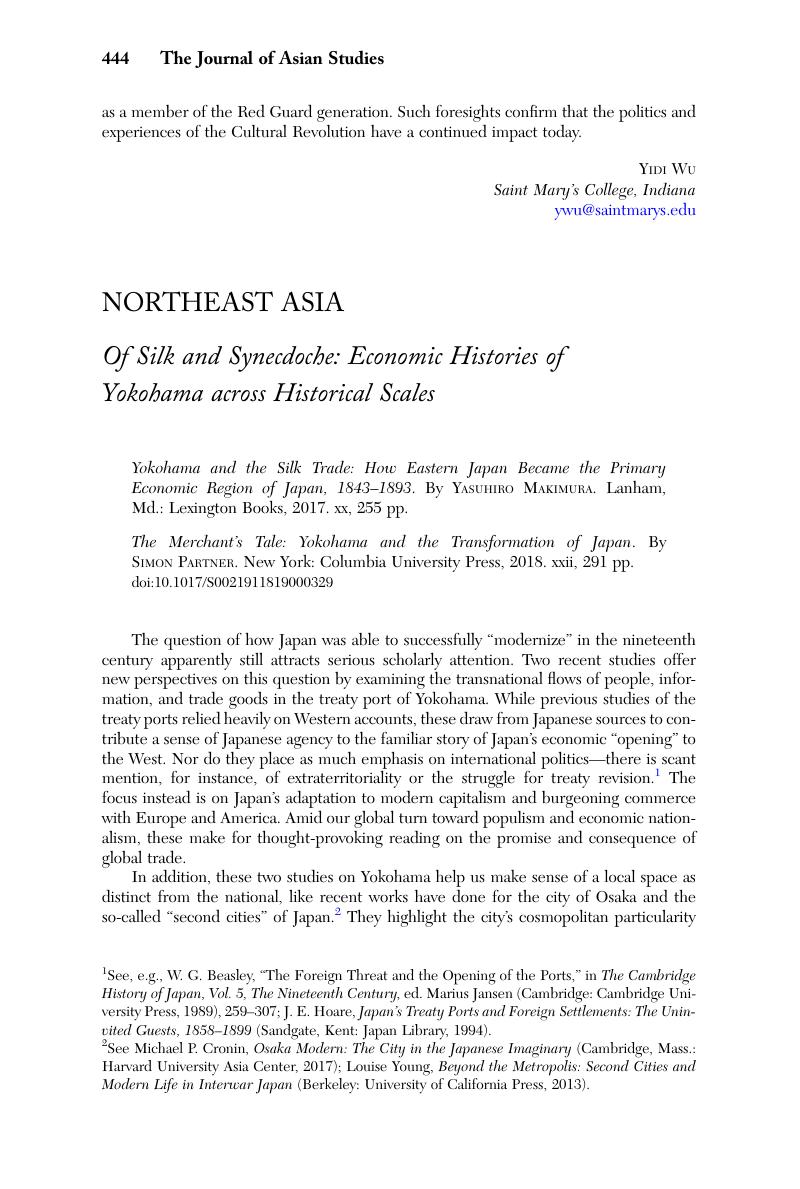No CrossRef data available.
Published online by Cambridge University Press: 10 May 2019

1 See, e.g., Beasley, W. G., “The Foreign Threat and the Opening of the Ports,” in The Cambridge History of Japan, Vol. 5, The Nineteenth Century, ed. Jansen, Marius (Cambridge: Cambridge University Press, 1989), 259–307Google Scholar; Hoare, J. E., Japan's Treaty Ports and Foreign Settlements: The Uninvited Guests, 1858–1899 (Sandgate, Kent: Japan Library, 1994)Google Scholar.
2 See Cronin, Michael P., Osaka Modern: The City in the Japanese Imaginary (Cambridge, Mass.: Harvard University Asia Center, 2017)CrossRefGoogle Scholar; Young, Louise, Beyond the Metropolis: Second Cities and Modern Life in Interwar Japan (Berkeley: University of California Press, 2013)CrossRefGoogle Scholar.
3 Daikichi, Irokawa, The Culture of the Meiji Period, trans. and ed. Jansen, Marius B. (Princeton, N.J.: Princeton University Press, 1988)Google Scholar; Keene, Donald, “The Sino-Japanese War of 1894–95 and Its Cultural Effects in Japan,” in Tradition and Modernization in Japanese Culture, ed. Shively, Donald H. (Princeton, N.J.: Princeton University Press, 1971), 121–75Google Scholar.
4 Most of the usual characters are present, including James C. Hepburn, Rutherford Alcock, Francis Hall, Cees de Coningh, Ernest Satow, John Reddie Black, Michael Moss, Charles Wirgman, and Felice Beato.
5 Ennals, Peter, Opening a Window to the West: The Foreign Concession at Kobe, Japan, 1868–1899 (Toronto: University of Toronto Press, 2013)CrossRefGoogle Scholar.
6 Consider for instance Robert Hellyer's argument that the shogunate was actively engaged in what he considers “proto-globalization.” Hellyer, Robert, Defining Engagement: Japan and global Contexts, 1640–1868 (Cambridge, Mass.: Harvard University Asia Center, 2009), 13Google Scholar.
7 This work refers to the man as Kōshūya Chūemon, identifying him not by family name but his shop name (yagō). This was a common custom prior to the Meiji era.
8 Granted, W. G. Beasley and Michael Auslin suggest that Hotta and Iwase were not unwilling in this sense, but do not argue that their position was decisive. See Auslin, Michael R., Negotiating with Imperialism: The Unequal Treaties and the Culture of Japanese Diplomacy (Cambridge, Mass.: Harvard University Press, 2004), 33Google Scholar; Beasley, “The Foreign Threat,” op. cit. note 1, 275–76.
9 This trade with China was predominant in the Tokugawa period and remained consequential through the opening of Japan to the Western powers in 1859. See, e.g., Hamashita, Takeshi, “The Tribute Trade System and Modern Asia,” in China, East Asia and the Global Economy: Regional and Historical Perspectives (London: Routledge, 2008), 12–26Google Scholar; Walker, Brett L., The Conquest of Ainu Lands: Ecology and Culture in Japanese Expansion, 1590–1800 (Berkeley: University of California Press, 2001)Google Scholar; Jansen, Marius B., China in the Tokugawa World (Cambridge, Mass.: Harvard University Press, 1992)CrossRefGoogle Scholar; Phipps, Catherine L., Empires on the Waterfront: Japan's Ports and Power, 1858–1899 (Cambridge, Mass.: Harvard University Asia Center, 2015)CrossRefGoogle Scholar.